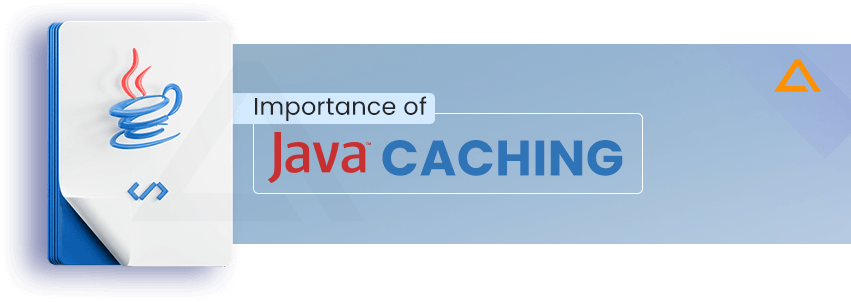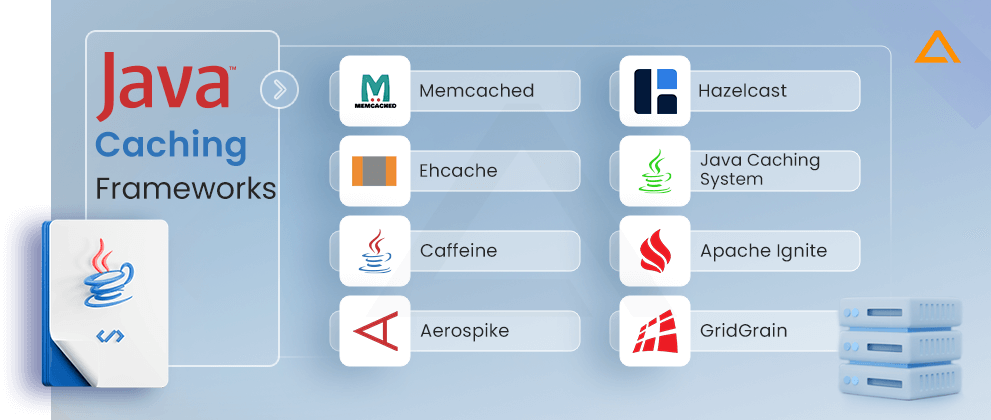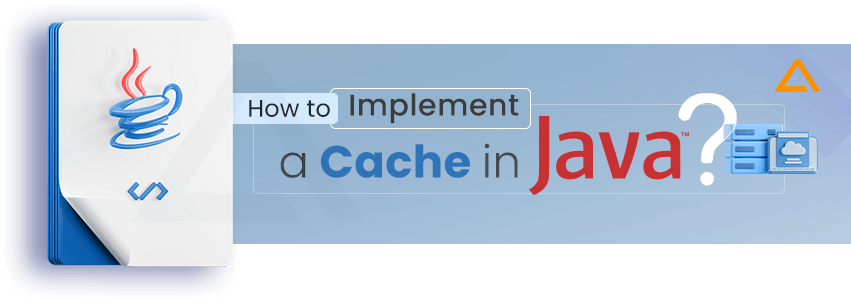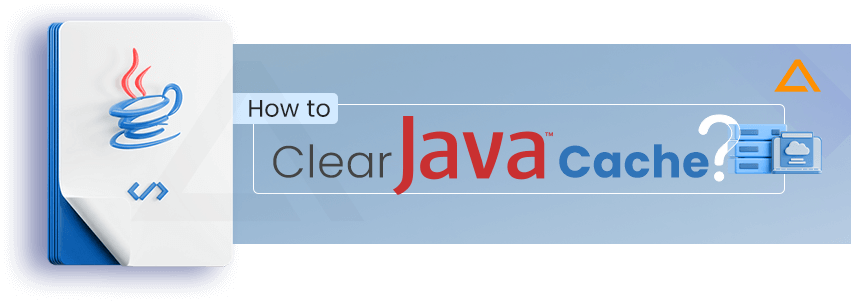Quick Summary:
Java caching enhances application performance by temporarily storing data in memory or on disk, reducing latency and minimizing database load. This blog explores how frameworks like Ehcache, Caffeine, Hazelcast, and Redis can improve data retrieval and resource efficiency. Effective caching requires strategic planning and robust frameworks to optimize speed and responsiveness
In this blog, we’re going to discuss📝
Caching plays a vital role in improving application performance by temporarily storing frequently accessed data in fast storage like memory, reducing the need for slower backend database or network calls. This leads to lower latency, faster processing, and better scalability.
For skilled Java developers, implementing caching is a key best practice, with versatile options ranging from simple in-memory caches to distributed caches. Open-source frameworks like Ehcache, Caffeine, and Hazelcast simplify the process.
This guide explores caching fundamentals, popular Java caching frameworks, and strategies for effective caching. It also covers real-world techniques, troubleshooting tips, and design considerations to help you optimize your Java applications for speed, scalability, and efficiency.
Let’s start with the overview of Java caching.
Java Caching Overview: Importance of Java Caching
Caching refers to temporarily storing data in a computer’s memory or storage for faster access. It provides rapid access to frequently used data to improve overall system performance. Caching stores a copy of data in temporary storage locations that can be accessed rapidly. It operates on the principle of locality of reference – recently and frequently accessed data is likely to be needed again. By providing quick access to cached data, overall system performance improves.

The Importance of Java Caching
Caching is critical for performance in Java applications. By keeping frequently accessed data in memory, caching allows applications to retrieve data faster by avoiding slow I/O operations. This improves response times and throughput.
Why Use Java Caching?
The significant benefits of using caching in Java include better performance, scalability, lower latency, and reduced infrastructure costs. Implementing intelligent caching strategies enables Java applications to handle higher loads and user growth more efficiently.

Performance Improvement
- Caching speeds up read operations by avoiding expensive queries to databases or external services. Data retrieval becomes faster.
- Frequently accessed data like latest articles or trending products can be served from low latency in-memory caches.
- Compute intensive processes like recommendation engines can cache results to avoid repeated computation.
Scalability
- Caching removes load from backend systems like databases, allowing them to scale better.
- Distributed caches can handle large loads by spreading data across many cache servers.
- Caching improves scalability in read-heavy workloads by reducing load on backends.
Lower Latency
- Retrieving data from a fast in-memory cache reduces latency vs a typical database query.
- Users get faster responses when cached data is leveraged. This improves experience.
Cost Savings
- Caching can reduce the infrastructure needs for databases and other systems since caching reduces load.
- Less load means lower compute, memory, and networking costs for expensive backend infrastructure.
Now that we it is clear why you should use Java caching. Let’s move forward to the types of Java cache available.
Types of Java Cache
Java caching is essential in the pursuit of enhancing application performance, and it plays a significant role in Java security. In our exploration, we will venture into the realm of diverse Java caching techniques, encompassing in-memory caching, distributed caching, and disk-based caching. We’ll accentuate their distinctive advantages and pinpoint the scenarios in which they excel. Primarily, there are three types of caching in Java:

- In-memory Caching
- Distributed Caching
- Disk-Based Caching
- Application-Level Caching
- HTTP Caching
- Database Caching
Let’s dive into detail of each.
Java In memory Cache
A Java in memory cache, or memory cache, stores frequently accessed data in a computer or server’s RAM. It speeds up data retrieval by eliminating the need to access slower storage like disks or databases. Widely used in Java apps, it optimizes performance for frequently accessed data, enhancing user experience and responsiveness.
Java Libraries/Tools: Java provides data structures such as Java.util.concurrent.ConcurrentHashMap and Java.util.HashMap for basic in-memory caching. You can use third-party libraries like Guava Cache and Caffeine for more advanced features.
Distributed Caching
A java distributed cache is a data caching mechanism that spans multiple networked servers or nodes. It enhances scalability, fault tolerance, and data retrieval speed by distributing and locally serving cached data across nodes. This technology is crucial for optimizing performance for high-traffic and distributed systems, like web applications and microservices.
Java Libraries/Tools: Some popular Java-based distributed caching frameworks include Hazelcast, Ehcache with Terracotta, and Redis (when used in a distributed mode).
Disk-Based Caching
Disk-based caching is a data storage technique that stores frequently accessed or critical data on disk drives, offering a balance between performance and data persistence. It enables applications to retrieve data more rapidly than fetching it from external sources, enhancing efficiency while maintaining data durability.
Java Libraries/Tools: You can implement disk-based caching using technologies like Apache DiskStore and the DiskStore feature in Ehcache.
Let’s move forward to both the merits and limitations of Java caching, shedding light on how developers can harness its advantages while mitigating its associated tradeoffs.
Application-Level Caching
Application-level caching involves storing data within the application to reduce the need for redundant processing or database access. This type of caching enhances performance by keeping frequently used objects or computation results readily available.
Java Libraries/Tools: Java provides data structures like java.util.concurrent.ConcurrentHashMap and java.util.HashMap for simple in-memory caching. For more advanced features, libraries such as Guava Cache and Caffeine can be used to manage cache entries and eviction policies.
HTTP Caching
HTTP caching stores responses from HTTP requests to minimize load times and reduce the number of requests sent to servers. This caching strategy is commonly used in web applications to improve performance by keeping frequently accessed web resources close to the client.
Java Libraries/Tools: While Java itself does not provide built-in HTTP caching, libraries and frameworks like Spring Cache and Apache HttpClient support HTTP caching mechanisms. These tools can manage and store HTTP responses, improving efficiency and speed.
Database Caching
Database caching involves storing the results of frequently executed database queries to minimize query execution time and reduce database load. This type of caching helps enhance application performance by avoiding repetitive database access for commonly requested data.
Java Libraries/Tools: Java offers various libraries for database caching, including Ehcache for integrating with Hibernate or JPA. Tools like Redis can be used as an external cache for database query results, and caching solutions like Caffeine can be configured to work with database interactions.
Benefits & Limitations of Java Caching
While java caching brings significant advantages in terms of enhanced performance & improved user experience, it has its tradeoffs and considerations. As we delve into the world of Java caching, it becomes essential to balance its remarkable benefits and potential complexities and challenges it may introduce.
The significant benefits of caching include:

- Faster access for reads by avoiding slow backend queries
- Improved application performance and scalability
- Reduced load on databases and web servers
- Decreased latency for frequently accessed data
The main trade-offs with caching are:

- Consistency issues if cache is not invalidated when data changes
- Increased memory usage for in-memory caching
- Complexity in managing Java distributed caches
- Stale cached data if entries are not refreshed properly
- Cached data is non-persistent and volatile
Now that you are aware of the advantages & disadvantages offered by caching, it is important that you should also be aware of the best caching mechanism in Java.
Java Caching Techniques
Those essential Java caching techniques can significantly improve application performance and efficiency. Let’s delve into each of these core Java caching techniques:

Lazy Loading
Lazy loading is a cache initialization technique that defers caching until the application requests explicitly data. This approach conserves memory, as the cache remains unpopulated until data is accessed, reducing resource usage and preventing unnecessary data loading overhead. Lazy loading is particularly suitable for scenarios where initial cache population may cause resource contention or significantly extend application startup times.
Advantages
- Reduced memory usage: Since the cache is not preloaded, memory is conserved until data is needed.
Use Cases
- Applications with large datasets that cannot fit entirely in memory.
- Scenarios where initial cache population could cause resource contention or long startup times.
Write Through
Write-through caching is a synchronization mechanism that ensures data integrity between the cache and the underlying data store (e.g., a database). With write-through caching, every write operation updates both the cache and the data store in real-time. This approach guarantees data consistency, as changes made to the cache are immediately reflected in the data store. It is advantageous in applications requiring strict data consistency between cache and data store, especially in infrequent write operations.
Advantages
- Data consistency: Data in the cache and data store are always in sync, reducing the risk of stale data.
Use Cases
- Systems that require robust data consistency between cache and data store.
- Applications where write operations are relatively infrequent.
Write Behind
Write-behind caching is an asynchronous caching technique that optimizes write operations by initially updating the cache and then asynchronously propagating these changes to the data store in the background. This approach enhances write performance and reduces write latency since users experience quicker write operations without waiting for data store updates. Write-behind caching is beneficial in systems where write operations are frequent, and eventual consistency between the cache and data store is acceptable.
Advantages
- Improved write performance: Write operations are not delayed by data store updates.
- Reduced write latency: Users experience lower latency for write operations.
Use Cases
- Systems with frequent write operations where high write latency is not acceptable.
- Applications where eventual consistency between cache and data store is acceptable.
Read Through
Read through caching is an automatic cache population strategy. When a cache miss occurs and requested data is not found in the cache, the cache automatically fetches the missing data from the underlying data store and populates the cache with it. This ensures that frequently accessed data is always available in the cache, improving read performance and reducing the frequency of cache misses. Read-through caching is particularly useful in applications where rapid and reliable access to frequently used data is essential.
Advantages
- Ensures that frequently accessed data is always present in the cache, reducing cache misses and improves read performance.
Use Cases
- Applications that require fast & reliable access to frequently used data.
- Scenarios where data access patterns are predictable, and its feasible to keep the cache populated.
Cache Aside
Cache-aside caching, also known as lazy loading, delegates cache management to the application code. In this approach, the application code is responsible for checking the cache before accessing data from the data store. If the data is not found in the cache (cache miss), the application retrieves it from the data store and then populates the cache. This technique offers complete control over cache access and update logic, making it suitable for complex caching requirements and scenarios where fine-grained control over caching is necessary.
Advantage
- Full control over cache access and cache update logic.
Use cases
- Applications with complex caching requirements or data access patterns.
- Scenarios where fine-grained control over caching is necessary.
TTL-based Expiry
Time-to-Live (TTL)-based expiry is a cache entry management strategy that involves setting a predetermined time duration during which cached entries remain valid. Once the specified TTL period elapses, the cached entries are automatically invalidated and removed from the cache. TTL-based expiry is beneficial for caching data with known expiration timeframes, such as session data or temporary data. It ensures that stale or outdated data is automatically removed from the cache, preventing the serving of obsolete information.
Advantages
- Ensures that stale data is automatically removed from the cache, preventing outdated information from being served.
Use Cases
- Caching data with a known expiration timeframe, such as session data, temporary data or frequency changing data.
Eviction Policies
Eviction policies are rules or algorithms used to determine which cache entries should be removed when the cache reaches its predefined capacity limit. Common eviction policies include Least Recently Used (LRU), Least Frequently Used (LFU), and First-In-First-Out (FIFO). These policies help optimize cache memory usage by removing less relevant or rarely accessed data, ensuring that the cache remains efficient and continues to serve the most valuable data. Eviction policies are particularly useful for managing cache size and prioritizing frequently accessed data.
Advantages
- Efficient use of cache memory by removing less relevant or rarely used data.
Use cases
- Managing cache size and preventing it from consuming excessive memory.
- Prioritizing frequently accessed data while removing less important or outdated data.
Cache Preloading
Cache preloading is a proactive caching technique where the cache is populated with data before actual requests, typically during application startup or off-peak hours. By proactively populating the cache with data that is anticipated to be frequently accessed, cache preloading reduces the likelihood of cache misses and improves application responsiveness. It ensures that commonly used data is readily available in the cache, enhancing overall system performance and user experiences. Cache preloading is particularly valuable in scenarios where predicting which data will be frequently accessed is possible, leading to optimized caching efficiency.
Advantages
- Ensures that frequently used data is readily available in the cache, reducing cache misses and improving application responsiveness
Use cases
- Scenarios where you can predict which data will be frequently accessed.
- Reducing cache misses and improving the user experience in applications with predictable access patterns.
- Multiple cart functions – add, update, remove, get, content, destroy, total, tax, subtotal, count, and search.
- Easy to learn and integrate in Laravel applications
- Lightweight and concise

Looking to hire Java Developers?
Our experienced Java developers @ Aglowid are here to fast-track your project with tailored solutions.
Java Caching Frameworks
Java caching frameworks are essential components in enhancing application performance, and they often work seamlessly with Top Java Frameworks. These frameworks provide robust implementations for in-memory, distributed, and disk caching, effectively handling caching logic, leaving developers to interact with the cache interface. Here is an overview of leading open-source Java caching frameworks. Let’s start this curated list of caching frameworks for Java:
Top Java Caching Frameworks in 2024

Memcached
GitHub Star: 13.4K | GitHub Fork: 3.3K | License: BSD-3-Clause
Memcached is a high-performance, open-source distributed memory caching technology that stores frequently accessed data in RAM to reduce database load and accelerate data retrieval in applications. Its ease of use, speed, and scalability make it a preferred choice for caching in distributed systems, web applications, and microservices, ensuring low-latency data access and improved system performance as traffic increases.
Key Features
- Cache Expiry (TTL)
- Data Partitioning
- Efficient Caching Algorithms
- Multi-Threaded
- Language Agnostic
- No Persistence
- Highly Scalable
- Community Support
- SASL Authentication
- Load Balancing
Ehcache
GitHub Star: 2K | GitHub Fork: 579 | License: Apache-2.0 license
Ehcache, a versatile Java caching framework, empowers applications with high-speed data storage solutions. It seamlessly combines java in-memory and disk-based caching to optimize data retrieval and responsiveness. Ehcache simplifies integration, offering pluggable cache loaders and writers for efficient data handling and cache listeners for event-driven actions. The framework’s extensive statistics tracking and robust java cache management make it a valuable choice for enhancing application performance through efficient data storage and retrieval.
Key Features
- In-memory and disk-based caching
- Distributed caching
- Cache replication
- Cache expiration policies
- Easy integration
- Dynamic cache management
- Pluggable cache loaders and writers
- Cache listeners
- Comprehensive statistics tracking
- Robust cache management
Caffeine
GitHub Star: 15.7K | GitHub Fork: 1.6K | License: Apache-2.0 license
Caffeine is a high-performance cache library java, empowers applications with rapid data retrieval through in-memory caching. It offers seamless integration, exceptional performance, and low-latency access to frequently used data. Versatile features of Caffeine make it an ideal choice for developing Java applications seeking to enhance responsiveness and efficiency. Caffeine provides a versatile and powerful solution for optimizing data access & performance.
Key Features
- In-memory caching
- Exceptional performance
- Low-latency data access
- Automatic cache management
- Advanced eviction policies
- Asynchronous loading
- Cache expiration support
- Simplified API
- Memory-efficient design
- Versatile and powerful caching solution
Hazelcast
GitHub Star: 6.1K | GitHub Fork: 1.8K | License: Hazelcast Community License
Hazelcast is a dynamic unified real-time data platform that seamlessly merges stream processing and rapid data storage, enabling organizations to promptly harness the power of data in motion for real-time insights. With its unique blend of stream processing capabilities and fast data storage, Hazelcast empowers users to swiftly respond to and leverage live data, facilitating real-time decision-making and fostering a highly responsive data-driven environment.
Key Features
- Unified Real-time Data Platform
- Rapid Data Store
- Stream Processing
- High Availability
- Distributed Caching
- Horizontal Scalability
- Fault Tolerance
- In-Memory Data Grid
- Distributed Computing
- Clustering Capabilities
- Data Partitioning
- Data Replication
- Comprehensive Management & Java Monitoring Tools
Java Caching System
GitHub Star: 93 | GitHub Fork: 49 | License: Apache-2.0 license
The Apache Java caching system stands as a pivotal asset in the quest for optimizing Java application performance. It achieves this by adeptly storing frequently accessed data, effectively mitigating delays in retrieving data from slower sources. While official documentation holds intrinsic value, broadening one’s perspective beyond it is imperative.
Relying on a diverse array of resources, including community forums and industry best practices, can provide a more comprehensive understanding of how to leverage the capabilities of Apache’s caching system adeptly. By doing so, Java applications can reap the benefits of heightened responsiveness and optimal resource utilization, aligning with professional standards for application performance enhancement.
Key Features
- In-Memory Data Storage
- Distributed Caching
- Cache Eviction Policies
- Cache Expiration
- Data Persistence
- Support for Complex Data Types
- Integration
- Customizable
- Scalability
- High Availability
- Monitoring and Management
Apache Ignite
GitHub Star: 4.8K | GitHub Fork: 1.9K | License: Apache-2.0 license
Apache Ignite is an advanced distributed database, caching, and processing platform designed for high-performance and scalability. It provides a unified in-memory data fabric that enhances data processing capabilities and reduces latency for both transactional and analytical workloads. Ignite supports a wide range of use cases, including real-time analytics, high-speed transactions, and distributed computing.
Relying on a diverse array of resources, including community forums and industry best practices, can provide a more comprehensive understanding of how to leverage the capabilities of Apache’s caching system adeptly. By doing so, Java applications can reap the benefits of heightened responsiveness and optimal resource utilization, aligning with professional standards for application performance enhancement.
Key Features
- In-memory Data Grid
- Distributed Caching
- SQL Query Support
- ACID Transactions
- High Availability
- Horizontal Scalability
- Data Partitioning and Replication
- Integration with Hadoop and Spark
- Advanced Security and Authentication
- Ignite Machine Learning and Compute Grid
Aerospike
GitHub Star: 1K | GitHub Fork: 174| License: Apache-2.0 license
Aerospike is a high-performance, scalable NoSQL database designed for real-time big data applications. It offers low-latency performance with high throughput, making it ideal for use cases such as fraud detection, recommendation engines, and real-time analytics. Aerospike’s architecture supports high availability, strong consistency, and efficient data storage.
Key Features
- High-Performance In-Memory and Disk Storage
- Low-Latency Access
- Strong Consistency and High Availability
- Distributed Architecture
- Automatic Data Sharding and Replication
- Strong Data Durability
- Complex Query Support
- Real-Time Analytics
- Comprehensive Management Tools
- Integration with Hadoop and Spark
GridGrain
GitHub Star: 135| GitHub Fork: 55| License: Apache-2.0 license
GridGain is an in-memory computing platform built on Apache Ignite, providing a high-performance, distributed in-memory data grid and compute grid. GridGain offers advanced features for both transactional and analytical processing, making it suitable for applications that require rapid data access and complex computations.
Key Features
- In-Memory Data Grid
- Distributed Computing and Processing
- ACID Transactions
- Advanced Query Capabilities
- Real-Time Analytics
- Horizontal Scalability
- Data Partitioning and Replication
- Integration with Apache Hadoop and Spark
- High Availability and Fault Tolerance
- Enterprise-Grade Security
Tabular Comparison of Java Caching Framework
| Feature | Memcached | Ehcache | Caffeine | Hazelcast | Java Caching System | Apache Ignite | Aerospike | GridGrain |
| GitHub Stars | 13.4K | 2K | 15.7K | 6.1K | 93 | 4.8K | 1K | 135 |
| GitHub Forks | 3.3K | 579 | 1.6K | 1.8K | 49 | 1.9K | 174 | 55 |
| License | BSD-3-Clause | Apache-2.0 license | Apache-2.0 license | Hazelcast Community License | Apache-2.0 license | Apache-2.0 license | Apache-2.0 license | Apache-2.0 license |
| In-Memory Caching | Yes | Yes | Yes | Yes | Yes | Yes | Yes | Yes |
| Disk-Based Caching | No | Yes | No | Yes | No | Yes | Yes | Yes |
| Distributed Caching | Yes | Yes | No | Yes | Yes | Yes | No | Yes |
| >Cache Expiry (TTL) | Yes | Yes | Yes | Yes | Yes | Yes | Yes | Yes |
| Cache Eviction Policies | Yes | Yes | Yes | Yes | Yes | Yes | Yes | Yes |
| Pluggable Loaders/Writers | No | Yes | No | No | No | Yes | Yes | Yes |
| Language Agnostic | Yes | No | No | No | No | Yes | Yes | Yes |
| Automatic Cache Management | No | No | Yes | No | No | Yes | Yes | No |
| Asynchronous Loading | No | No | Yes | No | No | Yes | No | Yes |
| Memory-Efficient Design | No | No | Yes | No | No | Yes | Yes | Yes |
| Scalability | Highly Scalable | Scalable | Not Scalable | Highly Scalable | Scalable | Scalable | Highly Scalable | Highly Scalable |
| High Availability | Yes | No | No | Yes | Yes | Yes | Yes | Yes |
| Comprehensive Management & Monitoring | No | No | No | Yes | Yes | Yes | Yes | Yes |
| Support for Complex Data Types | No | No | No | No | Yes | Yes | Yes | Yes |
| Customizability | No | Yes | No | Yes | Yes | Yes | Yes | Yes |
| Fault Tolerance | No | No | No | Yes | Yes | Yes | Yes | Yes |
How To Implement a Cache in Java?
Here are the steps for setting up caching in Java with code.

1. Getting started with your chosen caching framework
- Add caching dependency like Ehcache or Caffeine via Maven/Gradle
- Create a Cache Manager Instance
CacheManager cacheManager = new CacheManager();
For distributed caches, create HazelcastInstance
HazelcastInstance hzInstance = Hazelcast.newHazelcastInstance();
2. Configuring Cache Manager
- Configure Cache Manager in XML or Java config
<ehcache>
<diskStore path="/tmp/cache"/>
<defaultCache maxEntriesLocalHeap=10000/>
<cache name="myCache"/>
</ehcache>
- Setup disk stores, memory limits, defaults
- Define caches with configurations
3. Defining Cache Policies and Eviction Strategies
//TIME_TO_LIVE expiry
Cache myCache = manager.createCache("myCache", new CacheConfiguration().setTimeToLiveSeconds(120));
//LRU eviction policy
CacheConfiguration config = new CacheConfiguration().setEvictionPolicy(EvictionPolicy.LRU);4. Integrating Caching into Your Java Application
//Get cache instance
Cache cache = cacheManager.getCache("myCache");
//Cache read
Product product = cache.get("productId");
//Cache write
cache.put("productId", new Product());Best Practices for Caching in Java
Follow the steps below to use java cache effectively.
1. Implementing Cache Keys
// Hash mutable fields
int userIdHash = userId.hashCode();
// Include query filters
String key = productId + "-" + categoryId;2. Cache Invalidation & Refresh
//Expire after write
cache.put(product, 120); //TTL seconds
//Explicit invalidate
cache.invalidate(productId);
//Refresh entry
cache.put(productId, product);3. Handling Cache Misses
//Check cache first
Product product = cache.get(productId);
if(product == null) {
//Reload on miss
product = db.loadProduct(productId);
cache.set(productId, product);
}4. Monitoring & Tuning Cache Performance
//Check metrics
long hitRatio = cache.getHitRatio();
long misses = cache.getMisses();
//Tune based on metrics
cache.setPolicy(EvictionPolicy.LFU);
cache.setLimit(10000);Now that you know how to setup & effectively use Java caching. But it is also important to know how to clear Java cache. Let’s see it in detail.
How To Clear Java Cache?
Clearing the Java cache is an essential maintenance task for the smooth and efficient operation of Java applications. The Java cache, which stores temporary files, applets, and other resources, can sometimes become cluttered or contain outdated data, leading to performance issues or unexpected behavior.
For teams working on enterprise-level Java applications, it becomes even more important to maintain optimal performance. This is where the need to hire Java developers with a deep understanding of the platform comes into play, as they can manage such tasks efficiently. There are two ways in which you can clear the Java cache.

- Using Terminal
- Using Java Control Panel (For windows & Mac)
Let’s look at them in detail to understand better.
Method 1: Using Terminal
Using the methods, you can use the following code for clearing or invalidating Java Cache.
Clearing the Java Cache
-
Clear(): This method clears the entire cache and removes all the entries. But it is important to remember once it is done all the entries will be deleted and can cause the storm of re-populating entries.
cache.clear()
-
Invalidate(key): This method will invalidate cache entries based on key. It is useful for the fine-grained control.
cache.invalidate(productId);
-
invalidateAll(): This method will remove all the entries from cache. Remember it works same as clear() method.
cache.invalidateAll();
- evitExpiredElements(): This method is used to evict all expired elements based on TTL.
- Dispose (): Disposes cache manager and all resources.
Now let’s move towards the method 2 which will use java control panel and with the help of GUI navigate and clear the java cache.
Method 2: Using Java Control Panel for Clearing Java Cache
Clearing the java cache is a straightforward process, and you can do it through the Java Control Panel or by manually deleting cache files, whatever you’re more comfortable with. Below are the steps for both the methods.
Using Java Control Panel
- Open the Java Control Panel: Press the Windows key and type “Configure Java.” Select the “Configure Java” option from the search results to open the Java Control Panel.
- Access the Temporary Files Settings:
- In the Java Control Panel, go to the “General” tab.
- Click “Settings” under Temporary Internet Files:
- In the “Temporary Internet Files” section, click the “Settings” button.
- Delete Files: In the Temporary Files Settings window, you can choose to delete cached applications and applets by clicking the “Delete Files” button.
- Confirm Deletion: A confirmation dialog will appear. Click “OK” to confirm the deletion of cached files.
- Finish: Once the process is complete, click “OK” to close the Temporary Files Settings window.
- Exit and Save Changes: Click “Apply” and then “OK” in the Java Control Panel to save the changes and exit.
Manually Clearing Java Cache (Windows, macOS, and Linux)
-
If you prefer to clear the Java cache manually, you can follow these general steps. Please note that the exact location of Java cache files may vary depending on your operating system and Java version
-
Close All Java Applications: Make sure no Java applications or browser windows using Java applets are open.
- Locate the Java Cache Folder:
- On Windows: The Java cache is typically located in the C:\Users\<YourUsername>\ AppData\ LocalLow\ Sun\ Java\ Deployment\ cache directory. Replace <YourUsername> with your actual username.
- On macOS: You can find the Java cache at /Library/Caches/Java/.
-
Delete Cache Files: Within the cache directory, delete all the files and subdirectories. You can do this by selecting them and pressing the delete key or using the appropriate command in your file manager.
-
Empty Trash (if applicable): If you’re on macOS or Linux, make sure to empty the trash/recycle bin to completely remove the cache files.
-
Restart: After clearing the cache, it’s a good idea to restart your computer to ensure that all cached data is completely cleared from memory.
When deleting cache files manually, be careful as it might affect some Java apps. While it’s usually safe, check the app’s documentation or support for guidance if you’re unsure.

Don’t Break the Bank!
Keep the Quality Intact
with Our Web Developers
Wrapping Up!
In Nutshell, implementing robust Java caching best practices through mature cache library solutions like Ehcache or Hazelcast provides significant gains for application performance. Java caching reduces database loads, lowers latency, and enhances scalability. With proper planning around cache invalidation, consistency, and object sizing, judicious caching in Java delivers one of the highest returns on investment for optimizing data access and application speed.





 Say
Say